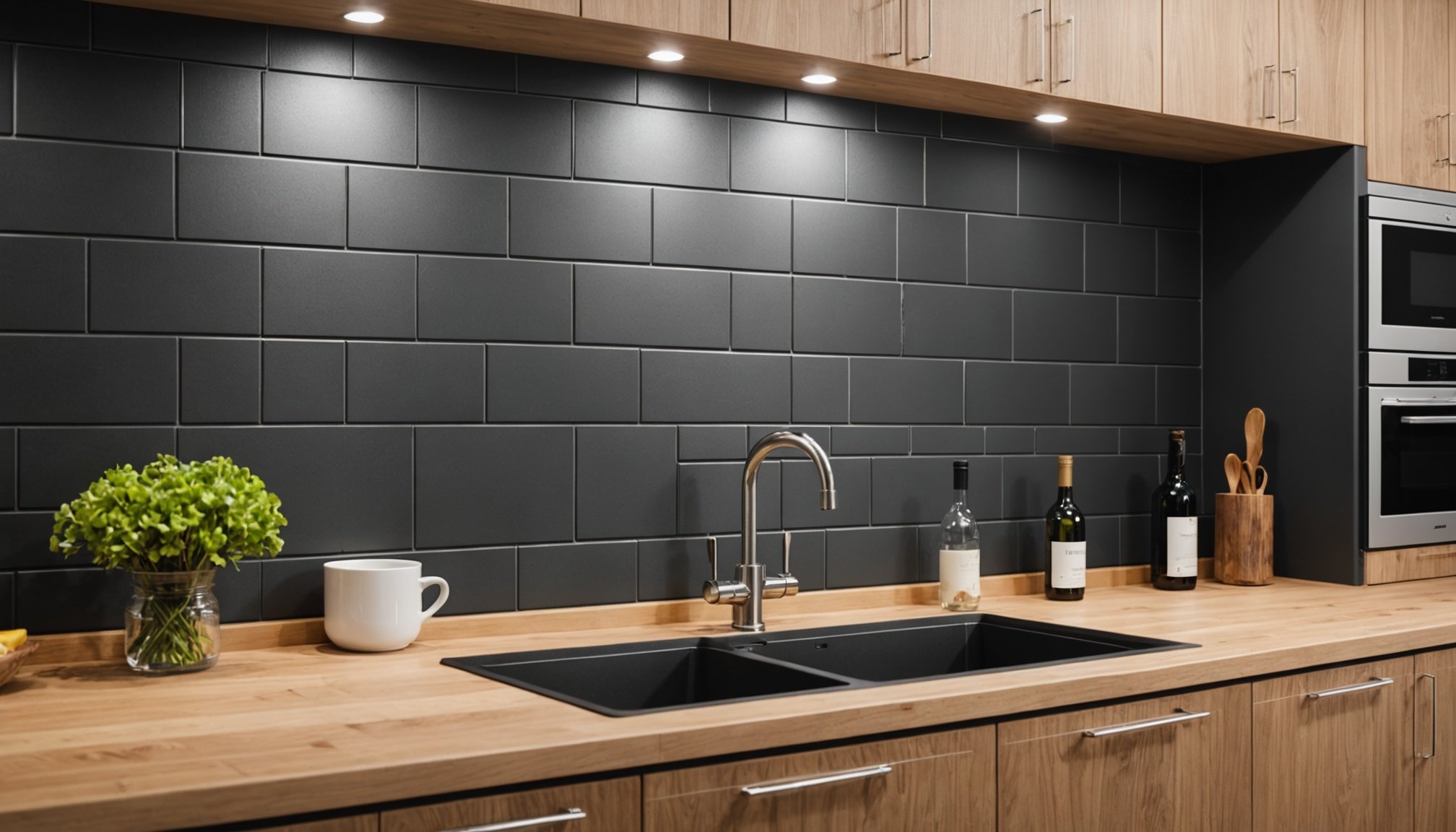Overview of Kitchen Backsplash Materials
Selecting the right kitchen backsplash materials is crucial for achieving both functionality and style. A well-chosen backsplash not only protects your walls from splashes and spills but also enhances the overall look of your kitchen, making it an integral part of a durable kitchen design.
In the UK, some of the most popular materials include ceramic tiles, glass, stainless steel, and natural stone. Ceramic tiles are a classic choice due to their durability and ease of cleaning. Glass backsplashes, on the other hand, offer a sleek and modern appearance, while also being resistant to stains. Stainless steel is highly durable and gives a contemporary, industrial look, making it a favourite for those seeking aesthetic backsplashes. Natural stone, such as marble or granite, provides a luxurious and timeless feel, though it may require more maintenance.
A lire également : Crafting elegant yacht decor: design tips for luxurious interiors
Current trends in kitchen backsplash designs emphasize bold patterns, mixed materials, and eco-friendly choices. More homeowners are opting for recycled glass or reclaimed wood to add character and sustainability to their spaces. Embracing these trends can transform your kitchen into a vibrant and environmentally-conscious area, offering a sophisticated backdrop for your culinary adventures.
Tile Backsplashes
Tile backsplashes have long been a favourite in kitchens and bathrooms due to their durability and aesthetic appeal. Among the most popular options are ceramic tile and porcelain tile, each with distinct characteristics that may influence your decision-making.
A lire en complément : Stylish Storage Solutions to Tidy Up Your UK Hallway: Balancing Elegance and Organization
Ceramic tiles are highly versatile and known for their wide range of colours and patterns, making them a stylish choice for various design themes. While they are typically more affordable and easier to cut and install, their porous nature makes them slightly less resistant to moisture compared to porcelain.
On the other hand, porcelain tiles are denser and less porous, offering superior water resistance and durability, which is particularly beneficial in a backsplash application. Their robust nature means they can withstand higher impact, making them suitable for high-traffic areas. However, they are typically more expensive and may require professional installation due to their hardness.
When considering the implementation of tile backsplashes, it’s important to account for the design versatility these materials offer. Various tile patterns, such as herringbone or subway, can create visually stimulating accents. Proper installation requires meticulous alignment and grouting, which underscores the value of detailed planning or seeking professional help.
Glass Backsplashes
Glass backsplashes are an invaluable asset in modern kitchen design, adding elegance and functionality. Their transparent surfaces enhance both light and space, creating a bright and airy feel. Glass naturally reflects light, making small kitchens appear more spacious and welcoming. This feature elevates the cooking area, making it the perfect place for culinary creativity.
When considering styles and colors, glass backsplashes offer a variety of options to suit different tastes. From clear and frosted finishes to vivid hues, there’s something for everyone. This versatility allows homeowners to tailor their backsplash to complement or contrast with existing kitchen elements, reinforcing the desired aesthetic.
Installation challenges are worth noting, as glass backsplashes require precise handling and secure installation. Ensuring the glass is properly cut and fitted minimizes any risk of breakage. Professional installers often recommend choices that align with the homeowner’s vision and the kitchen layout.
Maintenance is straightforward, with glass proving easy to clean and resistant to staining. This makes it an appealing choice for those seeking a low-maintenance option. Simply wiping it with a mild cleaner regularly keeps it looking pristine, maintaining its modern allure for years to come.
Stone Backsplashes
Stone backsplashes, a popular choice in modern kitchens, offer both durability and aesthetic appeal. Common types include granite, marble, and slate, each bringing unique qualities to your kitchen design. Granite, known for its hardness and heat resistance, stands up well to daily wear. Marble, while softer, captivates with its elegant veining, making it a chic addition to any culinary space. Slate adds a rustic charm with its rich, dark tones and natural texture.
The durability of natural stone is unparalleled, providing a long-term solution for homeowners seeking both function and beauty. However, this durability comes with a need for proper care to maintain its pristine condition. Regular sealing helps protect against stains and etching, particularly for porous stones like marble. Cleaning should be done with pH-balanced or stone-specific cleaners to avoid damaging the surface.
Despite these maintenance requirements, the appeal of stone backsplashes remains strong. Their timeless nature and resilience make them an excellent addition to any kitchen. By investing in routine care, you can ensure that your backsplash withstands the test of time, all while delivering a stunning backdrop for your cooking adventures.
Cost Considerations for Backsplash Materials
In exploring backsplash cost analysis in the UK, understanding the financial aspects is key. The average cost of backsplash materials can vary significantly depending on the type of materials. For instance, tiles or stainless steel might be considered moderately priced, with costs ranging typically from £15 to £50 per square metre. In contrast, natural stone and glass are regarded as luxury materials, with prices often soaring from £70 to £200 per square metre.
When selecting options for a backsplash on a budget, consider ceramic tiles or laminate as viable budget-friendly options. While they present a lower initial investment, these materials offer aesthetic appeal and durability. Conversely, premium materials such as marble or glass elevate the elegance of a kitchen but come with a heftier price tag.
The decision should also factor in the long-term value versus initial investment. While it may be tempting to opt for cheaper materials, investing in premium options can pay dividends in terms of durability and increased property value. Ultimately, the best choice hinges on balancing upfront costs with longevity and the desired aesthetic impact.
Installation Tips and Techniques
When considering a backsplash installation, deciding between a DIY kitchen project approach or opting for a professional installation can greatly influence the outcome. Choosing the right path can save you time, ensure quality, and potentially reduce costs.
Key Steps in DIY Installation versus Hiring a Professional
If you’re leaning towards a DIY approach, understanding the steps involved is crucial. First, prepare the wall by cleaning and priming it. Measure the area accurately to ensure a proper fit. Gather tools like tile cutters, adhesive spreaders, and spacers. However, professionals come equipped with experience, which can be beneficial for complex patterns or materials.
Tools and Materials Needed
For a DIY backsplash installation, you’ll need essential tools: a tile saw or cutter, level, and trowel. Materials like tiles, grout, and adhesives are necessary. These tools ensure that your installation is smooth, even, and visually appealing.
Common Pitfalls to Avoid
Avoiding common pitfalls can enhance your DIY kitchen project. Miscalculating dimensions or cutting tiles incorrectly can lead to uneven installations. Ensure you account for electrical outlets or switches. Adhesive setting times shouldn’t be rushed to maintain durability. By planning and preparing meticulously, your backsplash can transform your kitchen effectively.
Maintenance of Kitchen Backsplashes
Maintaining your kitchen backsplash effectively is crucial for ensuring its longevity and preserving its aesthetic appeal. An essential aspect of backsplash maintenance involves understanding the various materials used and their unique cleaning demands.
For tiled backsplashes, regular wiping with a damp cloth and mild detergent helps prevent dirt accumulation without damaging the grout. Glass backsplashes benefit from gentle, non-abrasive cleaners that leave them sparkling without scratches. Stone or marble options require special attention—opting for a pH-neutral cleaner can safeguard their natural beauty against harsh chemicals.
Specific Care Instructions
It’s equally important to embrace specific care techniques tailored to your backsplash material. As different surfaces react differently to cleaning agents, avoid universal solutions. Wood backsplashes need periodic oiling to retain moisture and prevent cracking or warping. Stainless steel varieties will shine with cleaners specifically formulated for metal surfaces, which also combat fingerprints and smudges.
Long-Term Maintenance
Finally, longevity is achievable through routine check-ups and appropriate sealing. Sealing porous materials like natural stone provides an additional layer of protection against moisture and stains, ensuring sustainability. With diligent care and informed choices, you can maintain the performance and appearance of your kitchen backsplash for years to come.
Visual Inspiration and Trends
In today’s UK kitchens, backsplashes are no longer just practical; they’re an integral part of the design. Among the leading kitchen backsplash trends, geometric patterns and bold colours have taken centre stage. These styles infuse a touch of modernity, blending seamlessly with contemporary kitchens’ sleek finishes.
Subway tiles, although a timeless classic, now see a twist with variations in size and texture, creating a unique design inspiration. Mirrored and metallic backsplashes are also gaining popularity, adding a luxurious touch and making smaller kitchen spaces feel more expansive.
When it comes to design inspiration, consider showcasing unique materials like reclaimed wood or smoked glass. These elements can introduce warmth and character, distinguishing your kitchen from the regular setups. Explore local resources for the best suppliers and installers who can transform these ideas into reality.
For those seeking local inspiration or looking to find the right materials and professionals, consider visiting home décor exhibitions such as ‘The Ideal Home Show’. These platforms provide ample opportunities to gather kitchen backsplash trends tailored to your taste, ensuring your kitchen reflects a personalised, sophisticated style.











